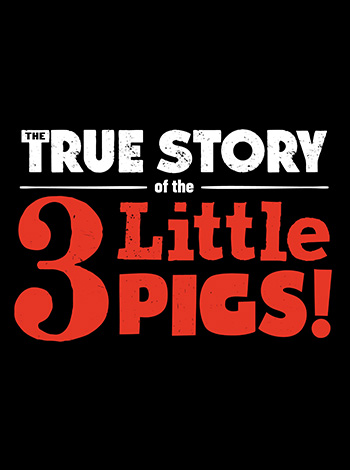Resource Guide - The True Story of the 3 Little Pigs!
About the show
You know the story. Three pigs build houses, the one who builds with bricks avoids the Big Bad Wolf and lives to tell the tale. But is that what really happened, or just porcine propaganda? In this brilliant parody of the famous fairy tale, we follow the Big Bad Wolf as he stands trial for his purported deeds. He has his own version of the story – and the audience becomes the jury, helping decide his fate: guilty or not guilty! Based on John Scieszka’s wildly popular book, this courtroom-force-meets musical is sure to please ... it would be a crime to miss it!THEMES: CONSIDERING DIFFERING VIEWPOINTS, DANGERS OF JUMPING TO CONCLUSIONS
Audience expectations
You may wish to have a discussion with your students about their role as an audience member. Live theatre only exists when an audience is present; their energy and responses directly affect the actors in performance.Younger audiences should know watching live theatre isn’t like watching more familiar forms of entertainment: there is no pause or rewind button, there are no commercials for bathroom breaks, and they can’t turn up the volume if someone else is talking. Encourage your students to listen and watch the play intently, so they may laugh and cheer for their favorite characters when it is appropriate. At the end of the play, your applause is an opportunity to thank the actors for their performance. Here are some other guidelines to remember as well:
- Respect other audience members. Stay seated and keep your hands to yourself.
- Please turn off all cell phones and other electronic devices during the performance.
- Photography and recording of the performance is prohibited by copyright law.
NCES-TheaArts.(K-5).TA.CU.2: Understand the traditions, roles, and conventions of theatre as an art form. NCES-TheaArts.3.TA.CU.2.1: Illustrate theatre etiquette appropriate to the performance situation.
The BIG questions about the show
- Who are some of the characters in the play that were not included in the book The True Story of the Three Little Pigs? Why do you think the playwright chose to add these characters to the play?
- Have you ever disagreed with someone about something that happened? How did you resolve the disagreement?
- Which version of the story do you think is true? What makes you think so?
CCSS.ELA-Literacy.SL.(K-5).2: Ask and answer questions about key details in a text read aloud or information presented orally or through other media. NCESHealthEd.4.ICR.1.1: Explain the importance of showing respect for self and respect and empathy for others.
Vocabulary enrichment
There are several difficult words in this play, but they are used in context with the story, so it should not be hard for your students to understand them. It might be interesting to assign one word to each member of the class to look up. Then each student could take a turn teaching a new word to the class!| sty | mournful | howling |
| infamous | carnivore | prosecutor |
| attorney | presiding | reaffirm |
| allegiance | defendant | domesticated |
| court appointed attorney | shenanigans | razorback |
| judgment | evidence | chagrin |
| resemblance | petulant | allotment |
| barbeque | indicate | maneuver |
| gullet | mausoleum | leading questions |
| rhetorical questions | hyperbolical questions | hostile |
CCSS.ELA-Literacy.L.(K-5).4: Determine or clarify the meaning of unknown and multiple-meaning words and phrases.
Activities
In the CourtroomSeveral individuals are involved in court proceedings. You can create a courtroom drama using another well known story with a conflict, or to solve a school issue.
- Judge: Ensures that both sides have an equal chance to present their cases. The judge must also decide if a law has been broken. It is his or her job to uphold the law.
- Plaintiff: The person who requests the court to hear the case. This person has accused another person (the defendant) of doing something that is unfair.
- Defendant: The person accused by the plaintiff. He or she listens to the charge and gives reason to try to prove that the charge is not true.
- Attorney (or lawyer): A professional who represents a plaintiff or defendant and helps to support their case.
- Jury: a group of people appointed to decide a verdict
- Verdict: a decision or judgment
Common Core Standards for English Language Arts and Literacy: SL2: Ask and answer questions about key details in a text read aloud or information presented orally or through other media; RL7: Make connections between the text of a story or drama and a visual or oral presentation of the text. 5.RL.3 Compare and contrast two or more characters, settings, or events in a story or drama, drawing on specific details in the text (e.g., how characters interact). NCES.HEALTH.(K-2).ICR.1: Understand healthy and effective interpersonal communication and relationships.
Building Materials
Brainstorm building materials for houses (from fantasy or reality): stones, brick, straw (thatched roof), logs, mud (adobe huts), animal hide, teepees, ice (igloo). Talk about the advantages and disadvantages of each one.- Bring into the classroom a variety of materials that can be used to build a model house: grass, sticks, legos, clay, fabric, metal, paper towel rolls, etc.
- Divide students into groups. Each group must build a model house using the available materials.
- After the houses are built, predict which houses would be able to withstand certain environmental elements such as wind, rain, floods or earthquakes. Chart your results.
- Test each model home. Use a hairdryer to simulate wind, a watering can to simulate rain, a rocking chairto simulate an earthquake. Compare results.
Common Core Standards for English Language Arts and Literacy: RL7: Make connections between the text of a story or drama and a visual or oral presentation of the text. NCES.VisArts.2.V.3: Create art using a variety of tools, media, and processes, safely and appropriately.
Additional Activities
For more activities and content surrounding this show, CLICK HERE to access Children’s Theatre of Charlotte’s Pinterest boards!Talk about jobs in the theatre
Every play Children’s Theatre of Charlotte produces is created by a talented team of designers, technicians, actors and a director. As a class, discuss what you experienced when you saw the performance.- Name three things you noticed about the set. Did the set help tell the story? What sort of set would you design?
- What did you like about the costumes? Did the costumes help tell the story? What sort of costumes would you design?
- Talk about the actors. Were there moments you were so caught up in the story you forgot you were watching a play?
- Were there any actors who played more than one character? What are some ways you can show you are a different character?
NCES-TheaArts.(K-5).TA.A.1: Analyze literary texts and performances. NCES-TheaArts.(K-5).TA.AE.1.2: Understand how costumes [and technical elements] enhance dramatic play.
Recommended Reading
If you enjoyed the show, travel to ImaginOn or your local Charlotte Mecklenburg library branch and check out these books. Check availability at cmlibrary.org.- The Three Little Wolves and the Big Bad Pig by Eugenios Trivizas
- The Three Little Fish and the Big Bad Shark by Ken Geist and Will Grace
- The Stinky Cheese Man and Other Fairly Stupid Tales by Jon Scieszka
- The Frog Prince Continued by Jon Scieszka

Book and Lyrics by Robert Kauzlaric | Music by Paul Gilvary and William Rush | Based on the book by Jon Scieszka and Lane Smith




